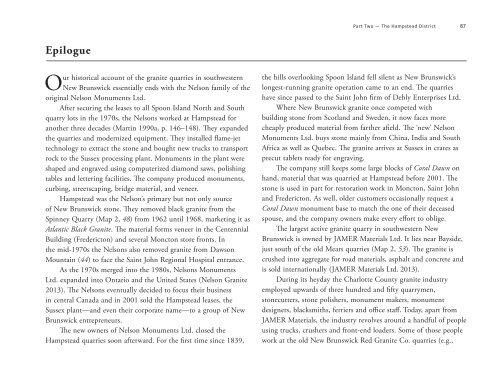The Granite Industry of Southwestern New Brunswick: A Historical ...
The Granite Industry of Southwestern New Brunswick: A Historical ...
The Granite Industry of Southwestern New Brunswick: A Historical ...
You also want an ePaper? Increase the reach of your titles
YUMPU automatically turns print PDFs into web optimized ePapers that Google loves.
Part Two — <strong>The</strong> Hampstead District 87<br />
Epilogue<br />
Our historical account <strong>of</strong> the granite quarries in southwestern<br />
<strong>New</strong> <strong>Brunswick</strong> essentially ends with the Nelson family <strong>of</strong> the<br />
original Nelson Monuments Ltd.<br />
After securing the leases to all Spoon Island North and South<br />
quarry lots in the 1970s, the Nelsons worked at Hampstead for<br />
another three decades (Martin 1990a, p. 146–148). <strong>The</strong>y expanded<br />
the quarries and modernized equipment. <strong>The</strong>y installed flame-jet<br />
technology to extract the stone and bought new trucks to transport<br />
rock to the Sussex processing plant. Monuments in the plant were<br />
shaped and engraved using computerized diamond saws, polishing<br />
tables and lettering facilities. <strong>The</strong> company produced monuments,<br />
curbing, streetscaping, bridge material, and veneer.<br />
Hampstead was the Nelson’s primary but not only source<br />
<strong>of</strong> <strong>New</strong> <strong>Brunswick</strong> stone. <strong>The</strong>y removed black granite from the<br />
Spinney Quarry (Map 2, 48) from 1962 until 1968, marketing it as<br />
Atlantic Black <strong>Granite</strong>. <strong>The</strong> material forms veneer in the Centennial<br />
Building (Fredericton) and several Moncton store fronts. In<br />
the mid-1970s the Nelsons also removed granite from Dawson<br />
Mountain (44) to face the Saint John Regional Hospital entrance.<br />
As the 1970s merged into the 1980s, Nelsons Monuments<br />
Ltd. expanded into Ontario and the United States (Nelson <strong>Granite</strong><br />
2013). <strong>The</strong> Nelsons eventually decided to focus their business<br />
in central Canada and in 2001 sold the Hampstead leases, the<br />
Sussex plant—and even their corporate name—to a group <strong>of</strong> <strong>New</strong><br />
<strong>Brunswick</strong> entrepreneurs.<br />
<strong>The</strong> new owners <strong>of</strong> Nelson Monuments Ltd. closed the<br />
Hampstead quarries soon afterward. For the first time since 1839,<br />
the hills overlooking Spoon Island fell silent as <strong>New</strong> <strong>Brunswick</strong>’s<br />
longest-running granite operation came to an end. <strong>The</strong> quarries<br />
have since passed to the Saint John firm <strong>of</strong> Debly Enterprises Ltd.<br />
Where <strong>New</strong> <strong>Brunswick</strong> granite once competed with<br />
building stone from Scotland and Sweden, it now faces more<br />
cheaply produced material from farther afield. <strong>The</strong> ‘new’ Nelson<br />
Monuments Ltd. buys stone mainly from China, India and South<br />
Africa as well as Quebec. <strong>The</strong> granite arrives at Sussex in crates as<br />
precut tablets ready for engraving.<br />
<strong>The</strong> company still keeps some large blocks <strong>of</strong> Coral Dawn on<br />
hand, material that was quarried at Hampstead before 2001. <strong>The</strong><br />
stone is used in part for restoration work in Moncton, Saint John<br />
and Fredericton. As well, older customers occasionally request a<br />
Coral Dawn monument base to match the one <strong>of</strong> their deceased<br />
spouse, and the company owners make every effort to oblige.<br />
<strong>The</strong> largest active granite quarry in southwestern <strong>New</strong><br />
<strong>Brunswick</strong> is owned by JAMER Materials Ltd. It lies near Bayside,<br />
just south <strong>of</strong> the old Mears quarries (Map 2, 53). <strong>The</strong> granite is<br />
crushed into aggregate for road materials, asphalt and concrete and<br />
is sold internationally (JAMER Materials Ltd. 2013).<br />
During its heyday the Charlotte County granite industry<br />
employed upwards <strong>of</strong> three hundred and fifty quarrymen,<br />
stonecutters, stone polishers, monument makers, monument<br />
designers, blacksmiths, ferriers and <strong>of</strong>fice staff. Today, apart from<br />
JAMER Materials, the industry revolves around a handful <strong>of</strong> people<br />
using trucks, crushers and front-end loaders. Some <strong>of</strong> those people<br />
work at the old <strong>New</strong> <strong>Brunswick</strong> Red <strong>Granite</strong> Co. quarries (e.g.,
















